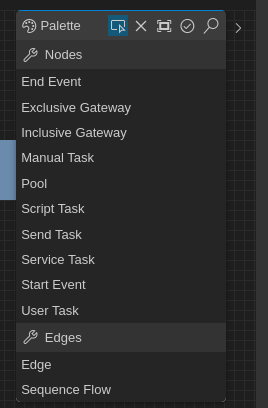Tool Palette Feature
GLSP provides different ways to provide command actions in the modeling pane to add new elements.
The ToolPaletteItemProvider
The ToolPalette is a graphical element shown all nodes and edges the user could place into a model. If you do not specify a custom Tool PaletteItemProvider, GLSP will automatically create a default Tool Palette for you, listing all your nodes and edges defined in your server model.

The items will be sorted in alphanumeric order and grouped by ‘Nodes’ and ‘Edges’. Of course you can define your own ToolPaletteItemProvider, for example to group your different CreationActions in a custom order. To do so you need to implement a ToolPaletteItemProvider and overwrite at least the method getItems.
The following example shows how to implement a custom ToolPaletteItemProvider:
public class BPMNToolPaletteItemProvider implements ToolPaletteItemProvider {
@Inject
protected OperationHandlerRegistry operationHandlerRegistry;
private int counter;
@Override
public List<PaletteItem> getItems(final Map<String, String> args) {
List<CreateOperationHandler> handlers = operationHandlerRegistry.getAll().stream()
.filter(CreateOperationHandler.class::isInstance)
.map(CreateOperationHandler.class::cast)
.collect(Collectors.toList());
counter = 0;
// Create custom sorted palette with groups
return Lists.newArrayList(
PaletteItem.createPaletteGroup("task-group", "Tasks", createPaletteTaskItems(), "symbol-property", "A"),
PaletteItem.createPaletteGroup("event-group", "Events", createPaletteEventItems(), "symbol-property", "B"),
}
/**
* Create a palette Item Group with all Task elements
*
* @return
*/
protected List<PaletteItem> createPaletteTaskItems() {
List<PaletteItem> result = new ArrayList<>();
result.add(new PaletteItem("manual-task", "Manual Task", new TriggerNodeCreationAction(ModelTypes.MANUAL_TASK)));
result.add(new PaletteItem("service-task", "Service Task", new TriggerNodeCreationAction(ModelTypes.SERVICE_TASK)));
result.add(new PaletteItem("send-task", "Send Task", new TriggerNodeCreationAction(ModelTypes.SERVICE_TASK)));
return result;
}
/**
* Create a palette Item Group with all Event elements
*
* @return
*/
protected List<PaletteItem> createPaletteEventItems() {
List<PaletteItem> result = new ArrayList<>();
result.add(new PaletteItem("start-event", "Start Event", new TriggerNodeCreationAction(ModelTypes.START_EVENT)));
result.add(new PaletteItem("end-event", "End Event", new TriggerNodeCreationAction(ModelTypes.END_EVENT)));
return result;
}
....
}
In this example we create three palette groups ‘Tasks’ and ‘Events’.
The method PaletteItem.createPaletteGroup expects a an unique ID, a label and the list of PaletteItem elements shown in this group. You can also provide a sorting hint for each group. For more information see also the implementation of DefaultToolPaletteItemProvider.
Binding
Finally you need to bind your custom ToolPaletteItemProvider in your server DiagramModule:
@Override
protected Class<? extends ToolPaletteItemProvider> bindToolPaletteItemProvider() {
return MyToolPaletteItemProvider.class;
}

The CommandPaletteActionProvider
Another Palette Feature is the CommandPalette. This command palette opens up on Ctrl+Space and shows actions in a specific context.

